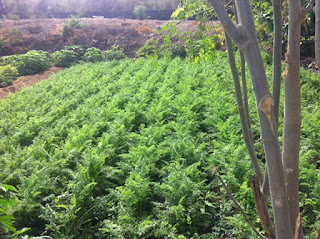São Vicente and Santo Antão
 There are two humanitarian couples in Cape Verde, ourselves on the southern (or sotavento/leeward) islands, and the Gerritsens on the northern ( or barlavento/windward) islands. The Gerritsens graciously invited all the senior missionaries to their islands for a little senior missionary adventure. We were able to go!
And what fun we had. We started with a tour of the Gerritsen's island, São Vicente, and went to beaches and saw a sea turtle and picked up seashells.
There are two humanitarian couples in Cape Verde, ourselves on the southern (or sotavento/leeward) islands, and the Gerritsens on the northern ( or barlavento/windward) islands. The Gerritsens graciously invited all the senior missionaries to their islands for a little senior missionary adventure. We were able to go!
And what fun we had. We started with a tour of the Gerritsen's island, São Vicente, and went to beaches and saw a sea turtle and picked up seashells.
 We also went toward the top of their highest mountain, Bruma seca and time constraints kept us from the view of the city below and nearby islands, but we met this fine fellow leading his donkey up the mountain.
We also went toward the top of their highest mountain, Bruma seca and time constraints kept us from the view of the city below and nearby islands, but we met this fine fellow leading his donkey up the mountain.
 That afternoon we took the ferry to the nearby, very beautiful island of Santa Antão.
Here is a photo of Elder Gerritsen, our host, on the ferry.
That afternoon we took the ferry to the nearby, very beautiful island of Santa Antão.
Here is a photo of Elder Gerritsen, our host, on the ferry.
 Here is a picture of elder Biven with "ferry hair". There was a real strong wind blowing and the ferry really rocked as we crossed the channel to Porto Novo on Santa Antao
Here is a picture of elder Biven with "ferry hair". There was a real strong wind blowing and the ferry really rocked as we crossed the channel to Porto Novo on Santa Antao

We stayed at a lovely hotel and enjoyed the food very much. The northern islands have more tourist visits than we do on our southern islands, so we enjoyed being tourists just a little.
The following day we took a tour of Santa Antao. The adventure began with Elder Gerritsen and Elder Biven climbing into the back of a truck with the luggage for a trip to pick up the Tour van.
 And then the extraordinary tour of Santa Antao began. The photos cannot do it justice, but at the end of the day Elder Biven and I agreed that we had seen the most spectacular scenery we had ever seen in our lives.
And then the extraordinary tour of Santa Antao began. The photos cannot do it justice, but at the end of the day Elder Biven and I agreed that we had seen the most spectacular scenery we had ever seen in our lives.
Here is a view of a village at the bottom of a cliff that we are driving along the ridge of.
 We all thought the three house built on an adjoining ridge were lovely.
We all thought the three house built on an adjoining ridge were lovely.
 Anderson, our driver. the road traveled along a precarious ridge with step drops on either side most of the way.
Anderson, our driver. the road traveled along a precarious ridge with step drops on either side most of the way.
What a beautiful place!
On the third day of our adventure we had returned to the island of Sao Vicente on the ferry and rested well, eaten ice cream, and went to the beach in the morning. We got some good photos of our traveling companions here. Later in the day we attended a baptism and had dinner overlooking the city before catching a late flight home.

What a Fantastic adventure we had! We are so grateful to our wonderful hosts the Gerritsens for their hospitality and enthusiasm. It has been such a pleasure working with them.


































